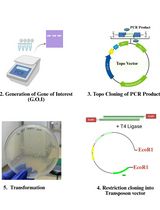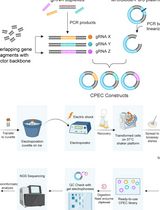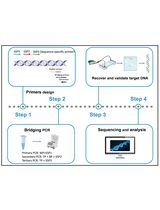- EN - English
- CN - 中文
Dense sgRNA Library Construction Using a Molecular Chipper Approach
使用分子碎片机方法构建密集覆盖的sgRNA文库
发布: 2017年06月20日第7卷第12期 DOI: 10.21769/BioProtoc.2373 浏览次数: 10848
评审: Gal HaimovichKabin XieAnonymous reviewer(s)

相关实验方案

利用Topo与限制性系统将基因克隆至转座子载体的简便可适应方法及其在鸡胚转基因中的应用
Pamela Kirimi [...] Yatinder Binepal
2025年08月20日 1759 阅读
Abstract
Genetic screens using single-guide-RNA (sgRNA) libraries and CRISPR technology have been powerful to identify genetic regulators for both coding and noncoding regions of the genome. Interrogating functional elements in noncoding regions requires sgRNA libraries that are densely covering, and ideally inexpensive, easy to implement and flexible for customization. We present a Molecular Chipper protocol for generating dense sgRNA libraries from genomic regions of interest. This approach utilizes a combination of random fragmentation and a Type III restriction enzyme to derive a dense coverage of sgRNA library from input DNA.
Keywords: Molecular chipper (分子碎片机)Background
Genome editing using Streptococcus pyogenes (sp) Cas9 and sgRNA libraries is a powerful tool to screen for functional genetic regulators in mammalian cells by generating biallelic loss-of-function sequence alterations (Wiedenheft et al., 2012; Mali et al., 2013; Koike-Yusa et al., 2014; Shalem et al., 2014; Wang et al., 2014; Zhou et al., 2014). Cas9 binds sgRNA, which can be designed to target Cas9 toward a defined locus in the genome. The nuclease activity of Cas9 cuts target DNA locus, leading to double-stranded DNA breaks, which upon DNA repair through non-homologous end-joining pathway frequently results in short deletions at the locus of interest.
The powerful genomic editing capacity of the CRISPR-Cas9 system has led to the use of sgRNA libraries to interrogate protein-coding genes as well as noncoding regions. Several sgRNA libraries for protein-coding genes and/or limited numbers of non-coding genes have been reported in functional screening, through sgRNA enrichment, to identify genes and networks regulating specific cellular functions (Koike-Yusa et al., 2014; Shalem et al., 2014; Wang et al., 2014; Zhou et al., 2014; Canver et al., 2015; Sanjana, 2016). Several non-coding sgRNA libraries consisting of 703-18,000 sgRNAs densely covering regulatory regions of genes of interest, such as BCL11A, Tdgf1a and drug-resistance regulating genes, were also reported in gene-specific functional screens for distal and proximal regulating elements (Canver et al., 2015; Rajagopal et al., 2016; Korkmaz et al., 2016; Sanjana, 2016). These sgRNA libraries were all produced by careful bioinformatics design, oligonucleotide synthesis on microarray, and cloning of oligonucleotide pool(s) into vectors. This synthetic approach has been very useful, but requires computational expertise for genome-wide sgRNA design and expensive microarray synthesis, and thus is challenging for most laboratories.
Enzymatically generated sgRNA libraries covering regions of repetitive genomic sequences or loci are useful for CRISPR-Cas9 imaging of genomic sequences or loci (Lane et al., 2015). Due to lack of high-density (~111 bp), such sgRNA libraries are not reported in screening for functional non-coding regions. Another enzymatic method was reported to generate high-density (~20 bp) sgRNA library from cDNA (Arakawa, 2016). This type of sgRNA library consists of cell source-specific, differentially expressed sequences, thus, was neither reported for applications in functional screening.
Without prior knowledge of the locations of critical noncoding-element-containing regions, functional mapping of noncoding genomic regions requires sgRNA libraries that densely populate regions of interest. The ideal method requires flexibility for adjusting the scale of sgRNA production to easily cope with this need. We describe here a detailed protocol of the Molecular Chipper approach that processes any input DNA piece(s) to generate a near base-resolution sgRNA library densely covering the input DNA of interest.
Materials and Reagents
- Pipette tips (prefer ones with filters to minimize contamination, such as those from Denville Scientific)
- Tubes (Denville Scientific, catalog number: C2170 )
- Petri dishes (Corning, Falcon®, catalog number: 351029 )
- NEB 5-alpha Electrocompetent E. coli (New England Biolabs, catalog number: C2989K )
- Retroviral vector pSUPER-CRISPR that contains and a puromycin selection marker and a U6 promoter to drive expression of sgRNA that is cloned at BamHI-HindIII sites (for details, see Cheng et al., 2016b).
Note: Please write us to request for this material. - T4 DNA ligase at 2000,000 U/ml (New England Biolabs, catalog number: M0202T ). Use in ligations where T4 DNA ligase is required in excess within a small volume, such as that described in step 2
- T4 DNA ligase at 400,000 U/ml (New England Biolabs, catalog number: M0202S )
- T4 polynucleotide kinase (New England Biolabs, catalog number: M0201S )
- Distilled water (AmericanBio, catalog number: AB02123-00500 )
- QIAquick PCR Purification Kit (QIAGEN, catalog number: 28104 )
- Agarose (AmericanBio, catalog number: AB00972 )
- Ethidium bromide, 10 mg/ml (Sigma-Aldrich, catalog number: E1510 )
- 3 M sodium acetate, pH 5.2
- 100% ethanol (AmericanBio, catalog number: AB00515-00500 )
- 70% ethanol (AmericanBio, catalog number: AB04010-00500 )
- 1 kb plus DNA standard (Thermo Fisher Scientific, InvitrogenTM, catalog number: 10787018 )
- Agarose, low melting point (AmericanBio, catalog number: AB00981 )
- 10 bp DNA standard (Thermo Fisher Scientific, InvitrogenTM, catalog number: 10821015 )
- NEBNext End Repair Module (New England Biolabs, catalog number: E6050S )
- 10,000x SYBR Safe DNA Gel Stain (Thermo Fisher Scientific, InvitrogenTM, catalog number: S33102 )
- QIAEX II Gel Extraction Kit (QIAGEN, catalog number: 20021 )
- QIAquick Gel Extraction Kit (QIAGEN, catalog number: 28704 )
- EcoP15I-adaptor oligonucleotide pair: sense aaaactcgagcagcagtggatccG and anti-sense /5phos/Cggatccactgctgctcgag (Integrated DNA Technologies; 25 nmole DNA oligo scale; Standard desalting purification). The anti-sense oligo has a 5’-phosphase modification
- 100 bp DNA standard (New England Biolabs, catalog number: N3231S )
- EcoP15I enzyme (New England Biolabs, catalog number: R0646L )
- PCI: Phenol:Chloroform:Isoamyl Alcohol 25:24:1, saturated with TE (10 mM Tris, pH 8.0, 1 mM EDTA) (Sigma-Aldrich, catalog number: P2069-100ML )
- Phenol, saturated with Tris, pH 7.5 (Thermo Fisher Scientific, Thermo ScientificTM, catalog number: 17914 )
- Chloroform (AmericanBio, catalog number: AB00350-00500 )
- PCI (Phenol:chloroform:isoamyl alcohol 25:24:1), Tris saturated (Roche Diagnostics, catalog number: 03117944001 )
- 3’ sgRNA backbone adaptor oligo nucleotide pair: sense /5phos/nngttttagagctagaaatagcaagttaaaataaggctagtccgttatcaacttgaaaaagtggcaccgagtcggtgc-tttttttaagctttat and anti-sense ataaagcttaaaaaaagcaccgactcggtgccactttttcaagttgataac-ggactagccttattttaacttgctatttctagctctaaaac (Integrated DNA Technologies, 100 nmole DNA oligo scale, Standard desalting purification). The -sense oligo has a 5’-phosphase modification
- BamHI-HF enzyme (New England Biolabs, catalog number: R3136S )
- HindIII-HF enzyme (New England Biolabs, catalog number: R3104S )
- MiniElute Gel Extraction kit (QIAGEN, catalog number: 28604 )
- LB medium (Thermo Fisher Scientific, InvitrogenTM, catalog number: 12795027 )
- QIAprep Spin Miniprep Kit (QIAGEN, catalog number: 27104 )
- Oligo nucleotide used in Sanger sequencing of cloned-sgRNA: ctccctttatccagccctca (Intergatred DNA Technologies, 25 nmole DNA oligo scale, Standard desalting purification)
- Ampicillin (AmericanBio, catalog number: AB00115-00100 )
- Tris base (Sigma-Aldrich, catalog number: T6066 )
- Ethylenediaminetetraacetic acid (EDTA) (Sigma-Aldrich, catalog number: EDS-100G )
- Glacial acetic acid (Sigma-Aldrich, catalog number: 695092 )
- Agar (AmericanBio, catalog number: AB01185-00500 )
- 50x TAE gel running buffer (see Recipes)
Equipment
- Pipettes
- 37 °C water bath (Fisher Scientific, model: Model 215 , catalog number: 15-462-15Q)
- NanoDrop 2000 (Thermo Fisher Scientific, model: NanoDropTM 2000 , catalog number: ND-2000)
- Microcentrifuge (Eppendorf, model: 5254 , catalog number: 022620444)
- S220 Focused-ultrasonicator and sonication vials (COVARIS, model: S220 )
- Gel Illuminator (UltraSlim LED Illuminator, Maestrogen, catalog number: SLB-01W )
- IncuBlock heating block (Danville Scientific, model: I-0259 , catalog number: 08302)
- Gel electrophoresis system (Thermo Fisher Scientific, Thermo ScientificTM, model: OwlTM EasyCastTM B1A , catalog number: B1A)
- Electroporation System (Bio-Rad Laboratories, model: Gene Pulser XcellTM, catalog number: 1652660 )
Procedure
文章信息
版权信息
© 2017 The Authors; exclusive licensee Bio-protocol LLC.
如何引用
Cheng, J., Pan, W. and Lu, J. (2017). Dense sgRNA Library Construction Using a Molecular Chipper Approach. Bio-protocol 7(12): e2373. DOI: 10.21769/BioProtoc.2373.
分类
分子生物学 > DNA > DNA 克隆
您对这篇实验方法有问题吗?
在此处发布您的问题,我们将邀请本文作者来回答。同时,我们会将您的问题发布到Bio-protocol Exchange,以便寻求社区成员的帮助。
Share
Bluesky
X
Copy link










